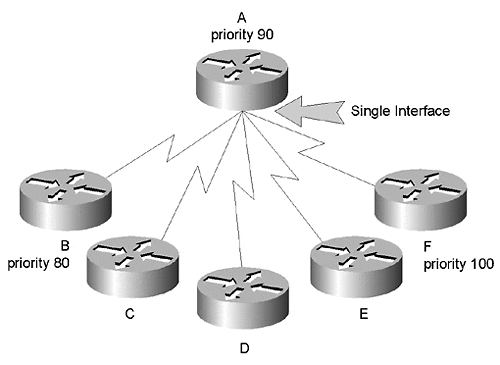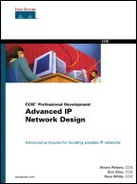OSPF and Nonbroadcast Multi-Access Networks
Nonbroadcast multi-access (NBMA) networks, such as the one depicted in Figure A-7, pose a special problem for OSPF and DR election. On a Cisco router, these networks can be configured to act as a single broadcast interface with multiple connections.
Figure A-7. An NBMA Network as a Point-to-Multipoint Network

Because Router A is using a single multipoint interface (a Frame Relay interface using inverse ARP or frame-map configurations to separate the traffic between the permanent virtual circuits [PVCs]) when Router A broadcasts a packet, all the other routers receive it. But when Routers B or F broadcast a packet, the only router that receives the packet is Router A.
Because all the routers connected to this multi-access network assume it is a single broadcast domain, they will attempt, unsuccessfully, to elect a BDR and DR. Assuming that all routers are connected to the link at the same time, the following scenario will occur:
Routers A and B will elect Router A as the DR and Router B as the BDR.
Routers A and F will elect Router F as the DR and Router A as the BDR.
Router B will not receive Router F's hellos.
Router F will not receive Router B's hellos.
Essentially, this is broken; there is no way to determine what the final outcome will be. It may actually work for some time until a link flaps or one of the routers on the network goes down.
There are three possible solutions to this problem:
Set all remote sites to OSPF priority 0, and the hub or core router to anything else.
Use point-to-point subinterfaces (on Cisco routers).
Configure the network as a point-to-point network type.
The first solution—configuring the OSPF router priorities—was the only solution for some time (before the availability of point-to-point subinterfaces or network type point-to-multipoint). Some network administrators, however, configure the remote routers with a low priority rather than a priority of 0, which works but can still cause problems because the BDR status will be in question. It is best to simply configure the remote routers to be ineligible to become DR or BDR.
The second solution—using point-to-point subinterfaces—has been available for some time now and has many advantages. It has one disadvantage that many administrators don't like, though: A separate network address must be used for each serial link. If a network has a lot of remote sites connected to distribution or access layer routers in this fashion, this can become a major administrative nightmare.
The final solution—network type point-to-multipoint—is a recent development. Instead of the hub router treating the NBMA network as a broadcast domain, it treats each PVC as a point-to-point link, building full adjacencies with each router. This technique is effective, but it results in the creation of host routes for each remote router on the NBMA network.
When considering which of these three solutions to use, you need to consider the advantages and disadvantages of each and decide which best suits your network.
